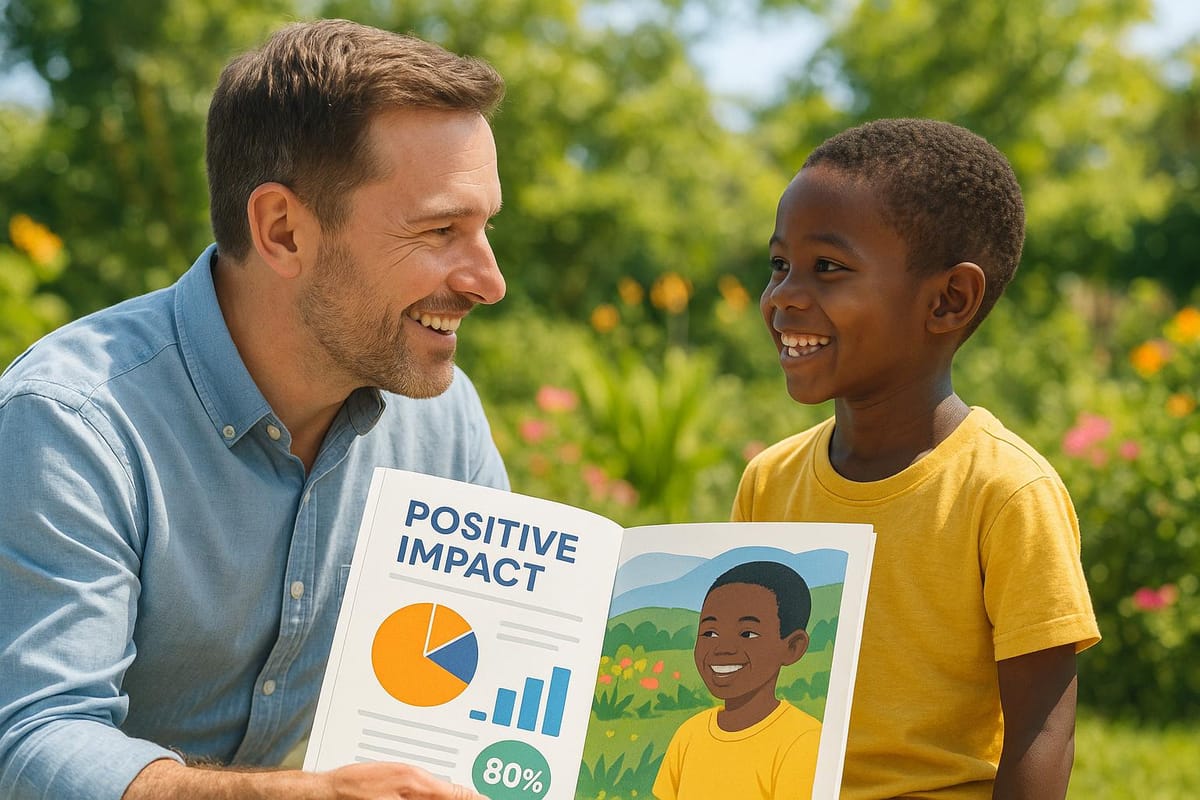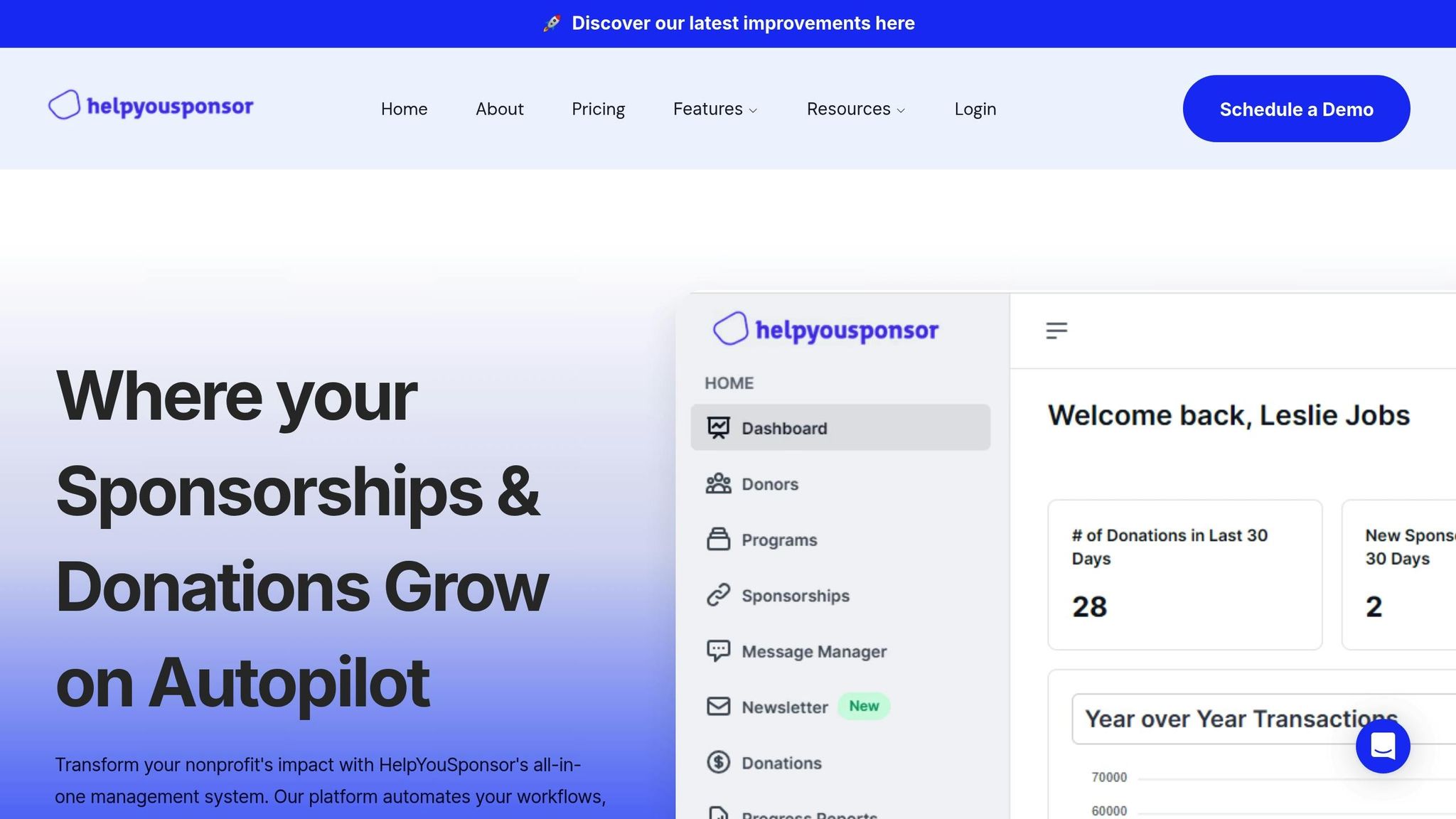Why Data-Driven Stories Inspire More Donors
Explore how data-driven storytelling enhances donor engagement by merging emotional narratives with measurable impact in child sponsorship programs.

Donors want two things: emotional stories and proof their contributions matter. Combining personal narratives with data achieves both, making it easier to connect with supporters and show real results.
Here’s why this works:
- Stories create emotional bonds. Sharing personal journeys, like Maria’s or Ahmed’s, helps donors feel connected to the cause.
- Data builds trust. Metrics like increased school enrollment or improved health outcomes show measurable impact.
- Visuals simplify complex data. Charts, graphs, and dashboards make progress clear and engaging.
- Regular updates keep donors engaged. Transparency through consistent communication strengthens long-term relationships.
How to Use Data Driven Impact Stories to Increase Funding and Donor Engagement
Problems with Current Storytelling in Child Sponsorship Programs
When it comes to child sponsorship programs, traditional storytelling methods fall short in two major ways: they’re tough to scale and lack the ability to truly personalize content for a wide range of donor needs. This creates a significant hurdle - crafting genuine, meaningful stories on a large scale becomes nearly impossible with these outdated approaches.
Challenges with Scaling and Personalizing Stories
The biggest limitation of traditional storytelling is its inability to grow and adapt. Producing engaging, heartfelt narratives for a large number of sponsored children requires significant resources - resources that many organizations simply don’t have. On top of that, if an organization lacks skilled storytellers on their team, the stories often end up feeling rushed and formulaic. Instead of drawing donors in, these uninspired narratives can push them away.
And when small teams with tight budgets try to scale their storytelling efforts, authenticity often takes a hit. The result? Stories that feel forced and fail to connect emotionally. Another issue is adapting these stories for various fundraising platforms. Without the ability to tailor content to different audiences and channels, the messaging loses its personal touch and overall impact.
"Balancing emotional appeal with factual accuracy, grappling with limited resources, and navigating diverse audience preferences are all hurdles to overcome for a nonprofit marketing/communications/fundraising team." ― Yeeboo Digital
How Data-Driven Storytelling Works
Data-driven storytelling is changing the way child sponsorship organizations connect with donors by blending hard facts with heartfelt personal stories. This approach combines emotional appeal with evidence of impact, creating a powerful way to inspire and persuade.
Combining Data with Personal Stories
When personal stories are paired with concrete data, the result can be incredibly compelling. Instead of just sharing an individual’s success, organizations can back it up with metrics like increases in education access or community development. This approach doesn’t just humanize the numbers - it also gives more weight to the personal story. By showing how one person’s journey mirrors broader progress, donors can see both the individual transformation and the larger ripple effect their support creates.
Strengthening Donor Engagement
Stories supported by data are more memorable and impactful. When donors see both the narrative and the numbers, it reinforces the message and strengthens their commitment. They can better understand how their contributions lead to real, measurable change.
Simplifying Data with Visuals
Complex data becomes much easier to grasp when it’s presented visually. Charts, infographics, and maps can turn program outcomes into something clear and shareable. For example, a line graph showing improvements in school enrollment or a before-and-after snapshot of nutrition levels can quickly convey the progress being made. Even better, interactive tools like online dashboards - offering real-time updates on achievements - can make the experience more personal, helping donors feel more connected to both the cause and the individual stories of success.
What Makes Data-Driven Stories Work
When it comes to combining data with storytelling, the most effective data-driven narratives strike a balance between emotional appeal and hard evidence. This combination inspires confidence and motivates donors to take action.
Metrics That Matter
Choosing the right metrics is key to creating a compelling story. Data like donor retention rates or campaign success metrics not only prove the effectiveness of your efforts but also build trust with your audience. Focus on numbers that align with your mission and are easy to understand.
For instance, metrics such as graduation rates or vaccination coverage provide a clear picture of your impact. Simple program statistics - like the number of children sponsored or meals provided - can also be incredibly powerful. Presenting these figures in easy-to-digest visual formats, such as charts, graphs, or infographics, makes the information more accessible. When these data points are paired with personal stories, they add both emotional depth and credibility to your message.
Personal Stories Backed by Data
Stories of individual successes, supported by clear statistics, engage both the heart and the mind. Research shows that narratives are far more memorable and impactful than raw numbers alone.
Take, for example, Ahmed, a sponsored child who recovered from illness thanks to medical care provided by your program. Sharing his journey alongside statistics that show improved health outcomes for sponsored children paints a fuller picture of your organization's impact. Experts like Tiffany Allen (Boss on a Budget) highlight that data-driven storytelling helps nonprofits stand out while quantifying their achievements for funders.
This approach caters to a range of donor motivations, appealing to both their emotional and rational sides. It ensures your message connects with a diverse audience.
Transparency and Regular Updates
While metrics and stories are important, maintaining open communication is equally vital for building and sustaining donor trust. Transparency and frequent updates demonstrate accountability and show donors the tangible results of their contributions.
Providing regular updates - whether through email newsletters or interactive dashboards - keeps donors informed about how their support is making a difference. For example, sharing progress on providing essential supplies or improving community health initiatives reinforces trust. Real-time dashboards, in particular, can strengthen donor relationships by offering a clear view of ongoing achievements.
Research confirms that blending stories with data not only creates a stronger connection but also builds credibility, encouraging long-term donor commitment. Organizations that embrace data sharing as a way to celebrate successes, highlight milestones, and address challenges honestly are better positioned to nurture lasting relationships with their supporters. This openness transforms one-time donations into enduring partnerships.
How to Use Data-Driven Storytelling in Child Sponsorship Programs
To make the most of data-driven storytelling, you need the right tools and systems to merge compelling narratives with meaningful data. These steps lay the groundwork for turning insights into action and ensuring smooth implementation.
Upgrade Your Data Collection and Visualization Tools
Effective storytelling starts with reliable data. Evaluate your current methods and focus on key metrics like donor retention, the number of children sponsored, and program outcomes to identify areas for improvement.
Training your team in data literacy is essential. They need to understand how to transform raw numbers into stories that resonate. For instance, instead of just stating that a program supports 500 children, you could create a timeline that illustrates growth - from 50 children in the first year to 500 in the fifth year. This approach highlights your program's progress and long-term impact.
Nonprofit-specific CRM tools and survey platforms can also help you gather and present both quantitative and qualitative data, completing the technical setup needed to tell stronger stories.
Build Systems That Combine Data and Stories
A structured system for pairing data with personal narratives is key. For example, you can share beneficiary stories alongside "before-and-after" statistics, such as improvements in literacy rates. Including personal milestones adds depth and makes the data more relatable.
Consistency is crucial. Regular updates not only keep donors engaged but also build trust. Campaigns that use storytelling alongside data have been shown to increase donations by 50% compared to data-only approaches. Additionally, establishing clear data governance policies ensures ethical handling of information while maintaining transparency and donor confidence.
Simplify Storytelling with HelpYouSponsor

Once your tools and systems are in place, platforms like HelpYouSponsor can take your efforts to the next level. Designed specifically for child sponsorship programs, this platform integrates data collection, analysis, and storytelling into one streamlined solution.
HelpYouSponsor allows organizations to track contributions, monitor individual child progress, and generate impactful reports that combine personal stories with data. By eliminating the need for multiple tools and manual processes, it ensures consistent communication with sponsors and delivers engaging, visual updates that strengthen donor relationships.
The platform is built by experts who understand the unique challenges of sponsorship programs. It addresses critical needs like managing sponsor relationships, tracking child progress, and creating personalized updates that blend data with heartfelt narratives.
HelpYouSponsor also offers a free plan for up to 10 commitments per month, making it easy for nonprofits to test data-driven storytelling, refine their approach, and expand as they see results. For organizations struggling with limited staff expertise in data analysis or challenges in integrating stories with statistics, the platform provides the tools and workflows to overcome these hurdles.
Old vs New Storytelling Methods
In the evolving world of nonprofit communication, the shift from traditional storytelling to data-driven methods marks a significant transformation. While emotional narratives have long been the cornerstone of fundraising, blending them with measurable data creates a more comprehensive and transparent approach. This combination resonates with modern donors, who seek both emotional connection and clear evidence of impact.
Traditional storytelling often focuses on personal hardship but struggles to showcase the long-term effectiveness of programs. On the other hand, data-driven storytelling enhances these emotional narratives by adding performance metrics - like improvements in literacy, school attendance, or educational outcomes. This approach not only deepens the emotional bond but also provides tangible proof of success, appealing to both the heart and the mind.
The difference becomes even more apparent when looking at donor retention. Emotional appeals alone can lead to donor fatigue once the initial impact fades. In contrast, data-driven storytelling keeps donors engaged by offering regular updates and visible progress, ensuring their continued support.
Comparison Table: Old vs Data-Driven Storytelling
| Aspect | Traditional Storytelling | Data-Driven Storytelling |
|---|---|---|
| Emotional Impact | Strong initial response through personal stories | Sustained connection with evidence of progress |
| Credibility | Limited due to lack of supporting data | Strengthened by measurable outcomes |
| Donor Engagement | Short-term enthusiasm, risk of fatigue | Long-term involvement with consistent updates |
| Accountability | Hard to demonstrate program success | Clear tracking of goals and results |
| Personalization | Broad, generic narratives | Tailored content aligned with donor interests |
| Scalability | Time-intensive, harder to replicate | Systematic and scalable with organizational growth |
| Trust Building | Relies on emotional appeal and goodwill | Builds trust through transparency and results |
| Donor Retention | Declines after initial impact | Improves with ongoing proof of success |
This comparison underscores the advantages of data-driven storytelling, particularly in building trust, maintaining donor engagement, and scaling efforts effectively. It sets the stage for nonprofits to adopt strategies that combine emotional appeal with measurable outcomes, ensuring a stronger connection with their supporters.
Conclusion: Getting More Donors Through Data-Driven Stories
The evolution from traditional storytelling to data-driven narratives has reshaped how nonprofits connect with donors. While emotional stories remain essential for creating a heartfelt connection, pairing them with measurable results amplifies their impact and builds a stronger foundation for fundraising efforts.
Data-driven storytelling bridges the gap between emotional appeal and tangible proof. It transforms vague claims into clear, measurable outcomes, fostering trust through transparency and regular updates. Today’s donors want more than just compelling anecdotes - they want evidence that their contributions are making a difference. Emotional stories ignite the desire to give, while data provides the validation that keeps donors engaged and committed.
To adopt this approach effectively, nonprofits need tools that can seamlessly integrate data collection with storytelling. Platforms like HelpYouSponsor simplify this process by enabling organizations to gather, organize, and present data alongside meaningful narratives. Features like integrated tracking and communication ensure nonprofits can maintain ongoing connections with their donors, reinforcing trust and engagement over time.
Nonprofits that embrace data-driven storytelling often see tangible benefits, including higher donor retention rates, increased trust, and sustained support. By blending personal stories with solid metrics, organizations can cultivate deeper, longer-lasting relationships with their donors - relationships that ultimately strengthen the impact on the communities they serve.
The key isn’t in repeating every step of the process but in prioritizing systems that merge storytelling with data. This balanced approach not only inspires generosity but also ensures a reliable and transparent fundraising strategy, paving the way for enduring partnerships and meaningful change.
FAQs
How can nonprofits use data to tell stories that inspire donors?
Nonprofits can transform data into compelling stories by tailoring their message to resonate with their audience and staying focused on a clear purpose. Start by pinpointing key metrics that highlight the organization's impact - like how many lives have been positively affected or how funds have been allocated to specific programs.
Using visuals, such as charts or infographics, can simplify complex information and make it more engaging. These tools help donors clearly see the real-world outcomes of their contributions. When combined with thoughtful storytelling, these insights strike the perfect balance between emotional connection and factual credibility, fostering trust and motivating donors to take action. By blending data with meaningful narratives, nonprofits can engage donors on both a personal and logical level, inspiring them to offer even greater support.
What challenges do nonprofits face when shifting from traditional storytelling to data-driven storytelling?
Nonprofits often face a variety of obstacles when shifting to data-driven storytelling. One major issue is ensuring the data is shared with enough context to make it resonate with the audience. Numbers by themselves can feel detached or abstract, making it harder to inspire donors or prompt action.
Another significant challenge involves preventing misinterpretation or oversimplification of the data. Poorly designed visuals or incomplete narratives can lead to confusion or even alienate the audience. On top of that, nonprofits often need to develop new skills in both data analysis and storytelling to strike the right balance between accuracy and engagement.
Despite these hurdles, embracing a data-driven approach enables nonprofits to craft stories backed by evidence - stories that not only foster trust but also encourage deeper donor involvement.
Why should nonprofits provide regular updates to donors, and how does it help improve donor retention?
Keeping donors in the loop with regular updates is crucial for maintaining a strong relationship. It not only shows them how their contributions are making a difference but also reinforces their trust in your organization. When donors see the real-world impact of their generosity, they feel more connected to the cause - and that emotional connection often inspires ongoing support.
Frequent updates also help donors feel like active participants in something meaningful. By sharing progress and results, nonprofits demonstrate accountability and show that every donation matters. This sense of involvement encourages long-term loyalty, which can significantly boost donor retention. Plus, focusing on retaining current donors saves time and resources that would otherwise go into finding new ones, allowing the organization to channel more energy into advancing its mission.

